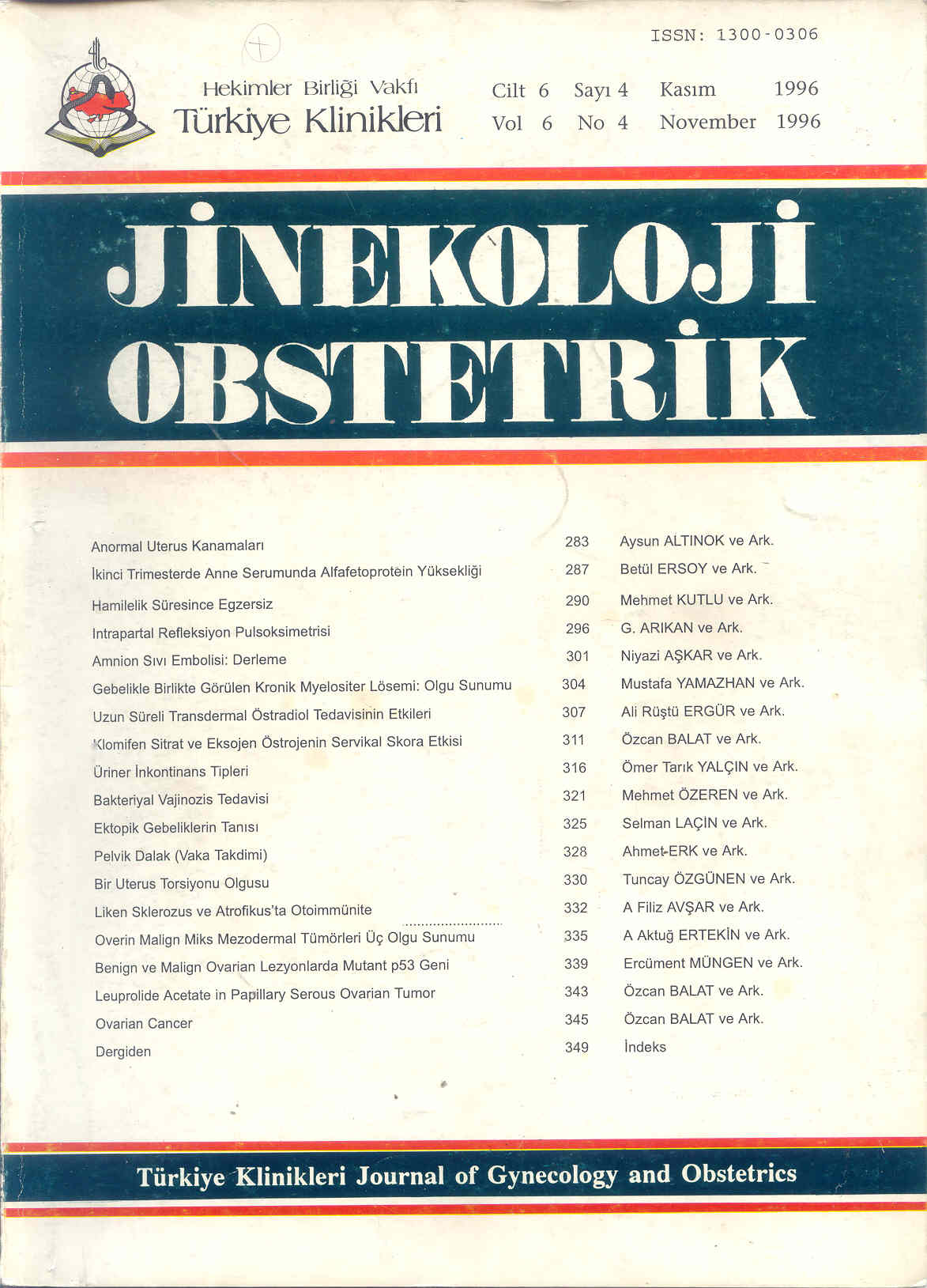Open Access
Peer Reviewed
ARTICLES
3211 Viewed1130 Downloaded
The Efficacy Of The Posterior Urethro-Vesical Angle Measurement For Diagnosing The Type Of Urinary Incontinence
Posterior Üretro-Vezikal Açı Ölçümlerinin Üriner İnkontinans Tipini Belirlemedeki Yeri
Turkiye Klinikleri J Gynecol Obst. 1996;6(4):316-20
Article Language: TR
Copyright Ⓒ 2025 by Türkiye Klinikleri. This is an open access article under the CC BY-NC-ND license (http://creativecommons.org/licenses/by-nc-nd/4.0/)
ÖZET
Amaç: Posterior üretro-vezikal açı (PUVA) değerlerinin üriner inkontinansın tipini belirlemedeki yerini araştırmak. Çalışmanın Yapıldığı Yer: Osmangazi Üniversitsi Tıp Fakültesi, Kadın Hastalıkları ve Doğum AD, Eskişehir. Materyel ve Metod: Üriner inkontinansı olan önceden anti inkontinans operasyonu geçirmemiş 43 hastada inkontinansın tipi iki basamaklı ürojinekolojik hasta değerlendirme protokolü ile araştırıldı ve transperineal ultrasonografi ile istirahat ve ıkınma sırasındaki PUVA değerleri ölçüldü. Bulgular: Anatomik stres inkontinans (ASI) tanısı alan 25, detrusör instabilitesi (DI) tanısı alan 8 ve miks tip inkontinans (MI) tanısı alan 10 hastada ortalama PUVA değerleri ve standart sapmaları istirahat anında sırası ile; 116.04 ± 22.35°, 109.25 ± 23.30° ve 124.50 ± 17.64°, ıkınma anında ise yine yine sırası ile; 143.12 ± 24.84°, 128.00 ± 14.57° ve 153.70 ± 17.63° olarak bulundu. Hastaların tümünde ıkınma sırasında ortalama PUVA değerlerinin istirahattakine göre anlamlı olarak yüksek olduğu saptandı (p< 0.01), DI olanların hem istirahat hem de ıkınma sırasındaki PUVA değerleri ASI ya da MI olanlara göre daha küçük olmasına rağmen aralarında istatistiksel anlamlı bir fark yoktu (p> 0.05). Sonuç: Üriner inkontinansı olan hastalarda istirahat ve ıkınma sırasındaki PUVA değerlerinin ya da ıkınma sırasında oluşan açı değişiminin inkontinans tiplerinin ayırıcı tanısında etkin bir parametre olmadığı düşünüldü.
Amaç: Posterior üretro-vezikal açı (PUVA) değerlerinin üriner inkontinansın tipini belirlemedeki yerini araştırmak. Çalışmanın Yapıldığı Yer: Osmangazi Üniversitsi Tıp Fakültesi, Kadın Hastalıkları ve Doğum AD, Eskişehir. Materyel ve Metod: Üriner inkontinansı olan önceden anti inkontinans operasyonu geçirmemiş 43 hastada inkontinansın tipi iki basamaklı ürojinekolojik hasta değerlendirme protokolü ile araştırıldı ve transperineal ultrasonografi ile istirahat ve ıkınma sırasındaki PUVA değerleri ölçüldü. Bulgular: Anatomik stres inkontinans (ASI) tanısı alan 25, detrusör instabilitesi (DI) tanısı alan 8 ve miks tip inkontinans (MI) tanısı alan 10 hastada ortalama PUVA değerleri ve standart sapmaları istirahat anında sırası ile; 116.04 ± 22.35°, 109.25 ± 23.30° ve 124.50 ± 17.64°, ıkınma anında ise yine yine sırası ile; 143.12 ± 24.84°, 128.00 ± 14.57° ve 153.70 ± 17.63° olarak bulundu. Hastaların tümünde ıkınma sırasında ortalama PUVA değerlerinin istirahattakine göre anlamlı olarak yüksek olduğu saptandı (p< 0.01), DI olanların hem istirahat hem de ıkınma sırasındaki PUVA değerleri ASI ya da MI olanlara göre daha küçük olmasına rağmen aralarında istatistiksel anlamlı bir fark yoktu (p> 0.05). Sonuç: Üriner inkontinansı olan hastalarda istirahat ve ıkınma sırasındaki PUVA değerlerinin ya da ıkınma sırasında oluşan açı değişiminin inkontinans tiplerinin ayırıcı tanısında etkin bir parametre olmadığı düşünüldü.
ANAHTAR KELİMELER: Transperineal ultrasonografi, posterior üretro-vezikal açı, anatomik stres inkontinans
ABSTRACT
Objective: Investigating the efficacy of the posterior urethro-vesical angle (PUVA) values for diagnosing the type of urinary incontinence. Institution: Osmangazi University, School of Medicine, Department of Obstetrics and Gynecology, Eskişehir. Material and Methods: Type of the incontinences were evaluated by two step urogynecologic patient evaluation protocol and PUVA values were measured by transperineal ultrasonography during resting and straining in 43 patient with urinary incontinence who had no anti incontinence operation previously. Result: The mean PUVA values and standart deviations of the 25 patients with anatomic stress incontinence (ASI), 8 patients with detrusor instability (DI) and 10 patients with mixed type of incontinence (MI) were found to 116.04 ± 22.36°, 109.25 ± 23.30° and 124.50 ± 17.64°, during resting and 143.12 ± 24.84°, 128.00 ± 14.57° and 153.70 ± 17.63° during straining respectively. The mean PUVA values during straining were significantly higher then those during resting in all of the patients with different type of incontinence (p< 0.01). Although the mean PUVA values of the patients with DI were smaller than those of the patients with ASI or MI. During resting and straining, the difference between the groups were not statisticaly significant (p> 0.05). Conclusion: It was suggested than PUVA values during resting and straining or increment of the angle during straining in patients with urinary incontinence were not efficacious parameters for the differential diagnosis of the type of incontinence.
Objective: Investigating the efficacy of the posterior urethro-vesical angle (PUVA) values for diagnosing the type of urinary incontinence. Institution: Osmangazi University, School of Medicine, Department of Obstetrics and Gynecology, Eskişehir. Material and Methods: Type of the incontinences were evaluated by two step urogynecologic patient evaluation protocol and PUVA values were measured by transperineal ultrasonography during resting and straining in 43 patient with urinary incontinence who had no anti incontinence operation previously. Result: The mean PUVA values and standart deviations of the 25 patients with anatomic stress incontinence (ASI), 8 patients with detrusor instability (DI) and 10 patients with mixed type of incontinence (MI) were found to 116.04 ± 22.36°, 109.25 ± 23.30° and 124.50 ± 17.64°, during resting and 143.12 ± 24.84°, 128.00 ± 14.57° and 153.70 ± 17.63° during straining respectively. The mean PUVA values during straining were significantly higher then those during resting in all of the patients with different type of incontinence (p< 0.01). Although the mean PUVA values of the patients with DI were smaller than those of the patients with ASI or MI. During resting and straining, the difference between the groups were not statisticaly significant (p> 0.05). Conclusion: It was suggested than PUVA values during resting and straining or increment of the angle during straining in patients with urinary incontinence were not efficacious parameters for the differential diagnosis of the type of incontinence.
MENU
POPULAR ARTICLES
MOST DOWNLOADED ARTICLES





This journal is licensed under a Creative Commons Attribution-NonCommercial-NoDerivatives 4.0 International License.










